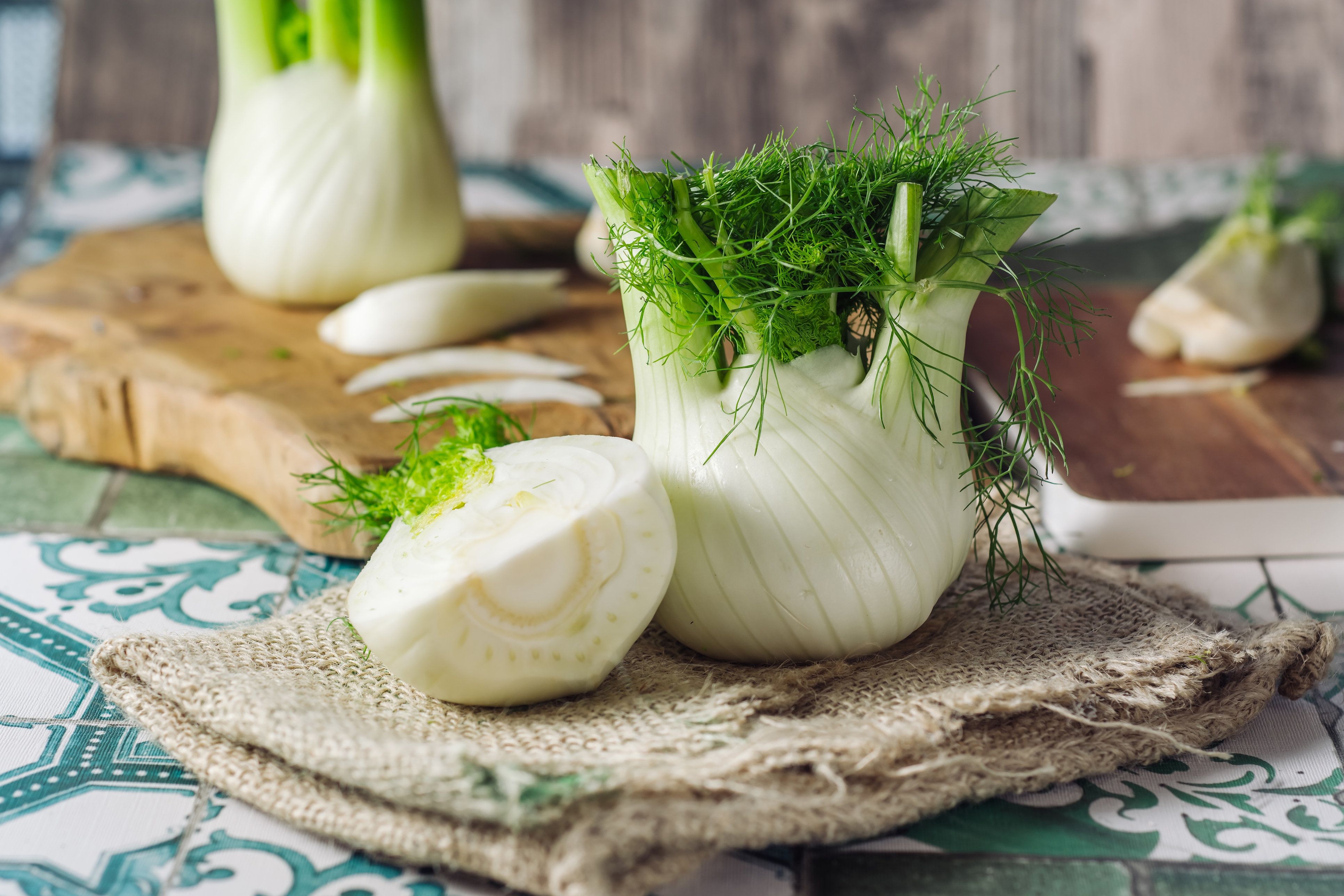Fennel Bulb
Fennel is a very aromatic and fibrous vegetable and herb in the stalks, stems, and shoots category. Another way to categorize fennel, based on it's aroma is to say that it is umbelliferous. In that sense, it is similar to celery and parsley. The composition and appearance of fennel stalks also looks a like celery. The French name is fenouil.
The main edible part of fennel is the bulb; the large, round portion at the base of the plant. The fronds (tops) are also edible. They are like the feathery leaves of the plant. They look like fresh dill but they taste like anise. Fennel seeds, when fresh off the plant, are very pungent but delicious.
Florence fennel has broader leaves (layers) and is otherwise used the same as ordinary fennel.

Growing Conditions
Fennel grows very hardily due to its strong cellular structure and supportive fibres. The plant can grow up to 4-5 feet tall.
When fennel seeds are in bloom, pick them fresh and harvest them right away or let them air dry at room temperature.
If the fennel plant is flowering then the bulb will be very mature and tough.
History
Fennel was (and is) widely enjoyed throughout the Mediterranean region as well as in Portugal where it grows wild. In the 17th century it was a main ingredient in cooking.
Ways to Cook
The flavour of fennel suits other Mediterranean flavours such as herbs, onions, citrus, pork, chicken, fish, olives, garlic, capers, and tomatoes.
Fennel bulb is a great ingredient to use:
- shaved in salads
- julienne or thinly sliced in soups
- pickled and added to salads, cold dishes, or as a contrast to roast meats in side sandiwches
- Roasted in large pieces
- Grilled and tossed in oil and herbs
- low and slow methods like stews and sous vide cooking
- juiced and blended with greens in smoothies
- sautéed
- in white stocks
Make sure to slice "against the grain" since it is very fibrous which allows for tender chewing. If shaving fennel bulb, use a mandolin for very thin and even slices, then submerge in ice water to make the fennel curl naturally and crisp up for a very crunchy texture.
Fennel fronds can be used like a fresh herb in salads or marinades. Fennel seeds can be eaten fresh and garnished on top of dishes, or pickled to add a tiny burst of flavour. The stalks of fennel are very tough to chew and almost too aromatic. Be careful if using under roasts so as to not overpower the other flavours. Baby fennel in the spring or summer can be quite nice. They are tender and a cute size to plate or mix with other baby vegetables but they are expensive.
More on Cooking Fennel
Some of our favourite videos
Alberta Fennel Producers
Riverbend Gardens
About this producerFoods from this producer:
-
- Vegetables
- Roots and Tubers
Beet
-
- Vegetables
Chard
-
- Vegetables
- Stalks, Stems, and Shoots
Asparagus
-
- Vegetables
Cucumber
-
- Vegetables
Zucchini
-
- Vegetables
- Cabbage Family
Cabbage
-
- Vegetables
- Leafy Greens
Kale
-
- Vegetables
- Cabbage Family
Broccoli
-
- Vegetables
Pumpkin
-
- Vegetables
- Roots and Tubers
Radish
-
- Vegetables
Onion
-
- Vegetables
Potatoes
-
- Vegetables
Corn
-
- Vegetables
- Stalks, Stems, and Shoots
Fennel Bulb
-
- Herbs & Spices & Flavourings
- Culinary Herb
Dill
-
- Vegetables
- Onion Family/Aliums
Leek
-
- Vegetables
- Roots and Tubers
Carrots
-
- Vegetables
Pea
-
- Vegetables
Green Bean
Poplar Bluff Organics
About this producerThe Jungle Farm
About this producerFoods from this producer:
-
- Grasses & Grains
Barley
-
- Vegetables
- Roots and Tubers
Beet
-
- Vegetables
Celery
-
- Vegetables
Cucumber
-
- Vegetables
- Stalks, Stems, and Shoots
Fennel Bulb
-
- Vegetables
- Onion Family/Aliums
Garlic
-
- Vegetables
- Leafy Greens
Kale
-
- Vegetables
- Onion Family/Aliums
Leek
-
- Vegetables
Lettuce
-
- Vegetables
Onion
-
- Vegetables
Pumpkin
-
- Fruit
Raspberry
-
- Vegetables
Chard
-
- Vegetables
Zucchini
-
- Fruit
Strawberry
